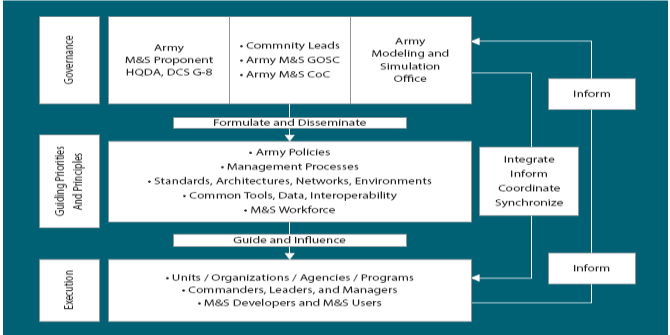The initial focus is on Training and Test & Evaluation communities, but many federates and tools are leveraged by, or derived from, other M&S communities.

The M&S Governance conducted an M&S Capability Portfolio Review to provide a holistic review of the Army M&S Enterprise, strategy, resourcing, and priorities. Though M&S is not considered a Portfolio, rather it is a cross-cutting capability that spans other portfolios, this framework was helpful to provide priorities to guide Army M&S Strategy Implementation activities, and will inform the Army POM for 2018.
All six of these communities were represented in the first Army M&S Capability Portfolio Review (CPR). The CPR identified an initial baseline of nearly 400 Army M&S tools in active use across the Army, including 48 Joint Defense tools and 22 Commercial-Off-the-Shelf products. Another significant outcome of the CPR was identification of common gaps across the Enterprise that provide focus for near-term investment and cross-community solutions. Not surprisingly, these gaps echo some of the Defense priority areas for M&S as discussed at the Training and Simulation Industry Symposium. The 2015 M&S CPR Cross-Community Gaps are: Cyber; Network Modeling; CBRN; Intel Environment; Terrain; Sensor; Resourcing; and Workforce Training. Many of the issues revealed in these gaps are expected to be addressed in the M&S Enterprise Architecture plan to be published in 2016. Other gaps will be addressed in the Draft M&S Data Strategy, being developed now. The CPR addressed each gap in terms of Issues; Community Impacts; Current Efforts; and Way-ahead.
As an example, Cyber Gaps are an immediate priority. The Army, along with other Defense agencies, needs to develop M&S capabilities to replicate cyber and its impacts in various models and simulations; to include impacts on aggregation at higher levels.
The Army has current efforts that will mitigate aspects of these gaps. The DoD Cyber Strategy (April 2015) directs the establishment of an enterprise-wide cyber modeling and simulation capability. There are also some Army efforts for Corps and below, and the Army’s inclusion in a broader DoD effort for Cyber Test Analysis and Simulation Environment Program. The Army’s M&S Enterprise Architecture plan (anticipated in 2QFY16) is expected to establish policies and standards that will update the current practices to include cyber. Of course, the issues raised are bigger than Army M&S, but the work being done now can be leveraged to affect other requirements.
Similar top-level assessments address the other gaps in areas of Network Modeling; Terrain; Chemical, Biological, Radiological, and Nuclear Defense (CBRN); Fires and Effect; Intel Environment.
The CPR Framework established the need for collaboration among the communities for current network modeling efforts. The M&S Governance structure is a reasonable mechanism that can develop and provide improved policies and standards to the Army’s M&S Enterprise Architecture plan (anticipated in 2QFY16).
The Army is currently drafting an M&S data strategy that is needed by all six communities and is a priority for the Army. Managing data and providing timely and effective access to the broad range of type, use, content and resolution will require cross-community coordination. The M&S Governance structure is ideal to leverage and advance the many capabilities and technologies that impact data and data products.
The Army is building a plan of action that will help reduce the time to prepare data products; minimize costs to produce integrated data products; improve the quality of data and products; and coordinate data initiatives. Many of the data and data products already exist in some form, however, investment is still needed to migrate those tools and services into available, multi-use tools and services. Other capabilities will require development and coordination to meet the vision and goals of the M&S data strategy.


